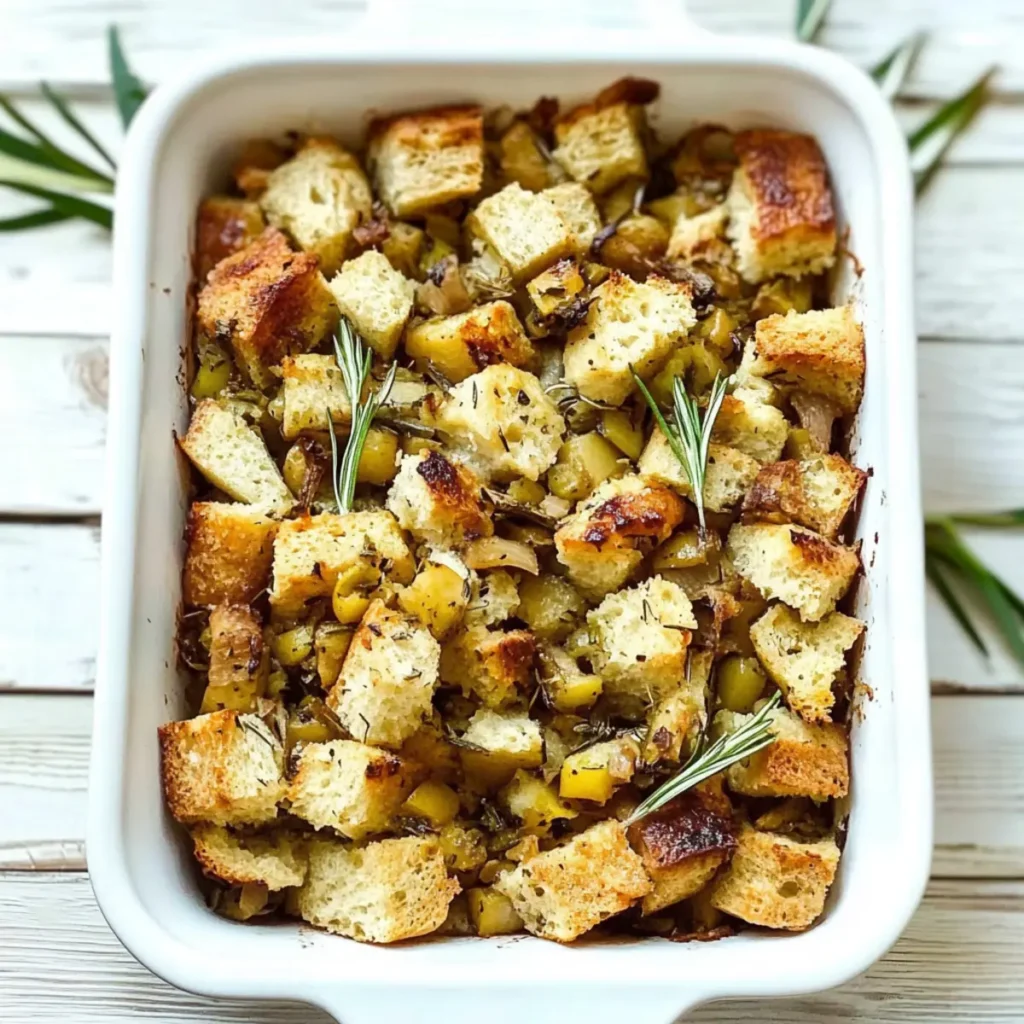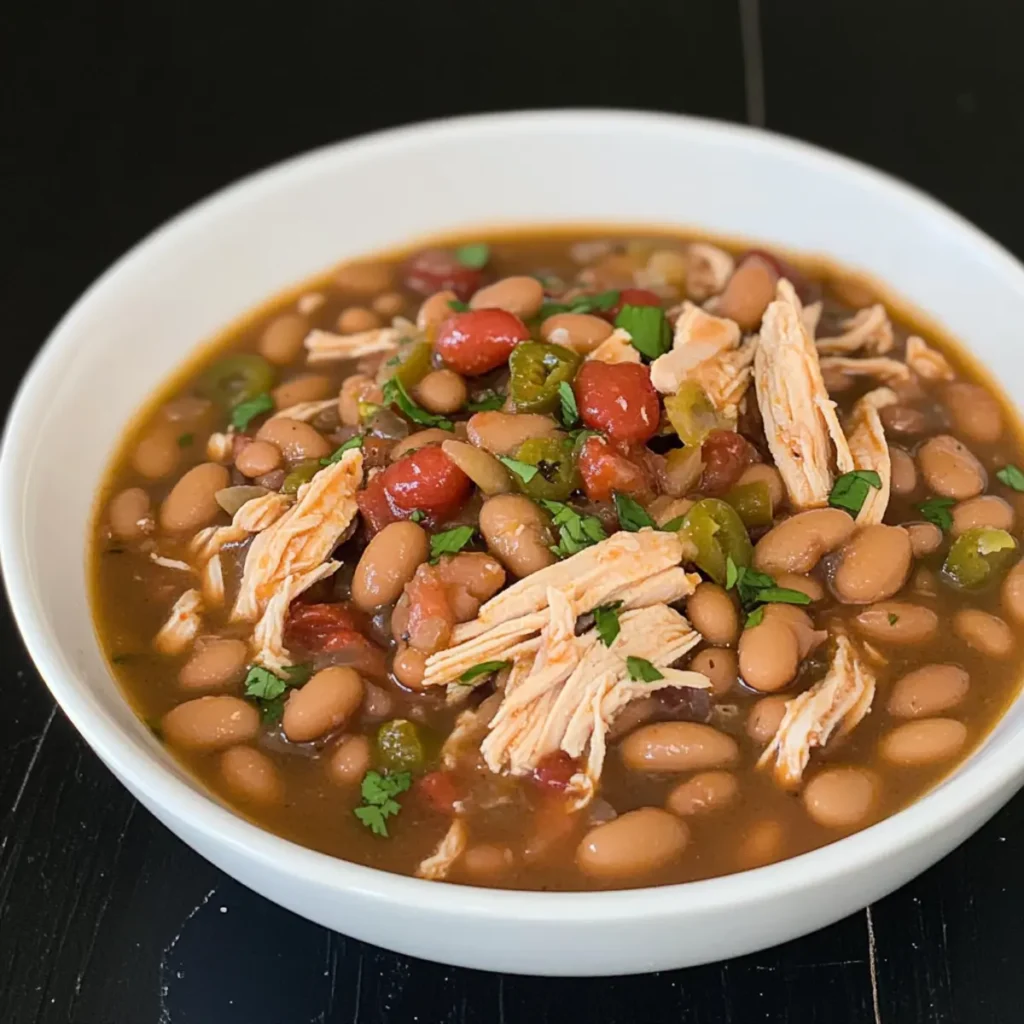Craving a taste of the sun-soaked Mediterranean without leaving your kitchen? Let me introduce you to my Savory Baked Mediterranean Vegetable Casserole—a dish that brings vibrant colors and fresh flavors straight to your table. This vegetarian delight features a medley of tender zucchini, creamy eggplant, and sweet bell peppers, all topped with a sprinkle of tangy feta. What’s even better? It’s beginner-friendly and can be prepped in just 20 minutes, making it perfect for both busy weeknights and leisurely weekends. Plus, with only 350 calories per serving, you can indulge without the guilt. Are you ready to explore the delicious world of Mediterranean cooking? Let’s dive in!
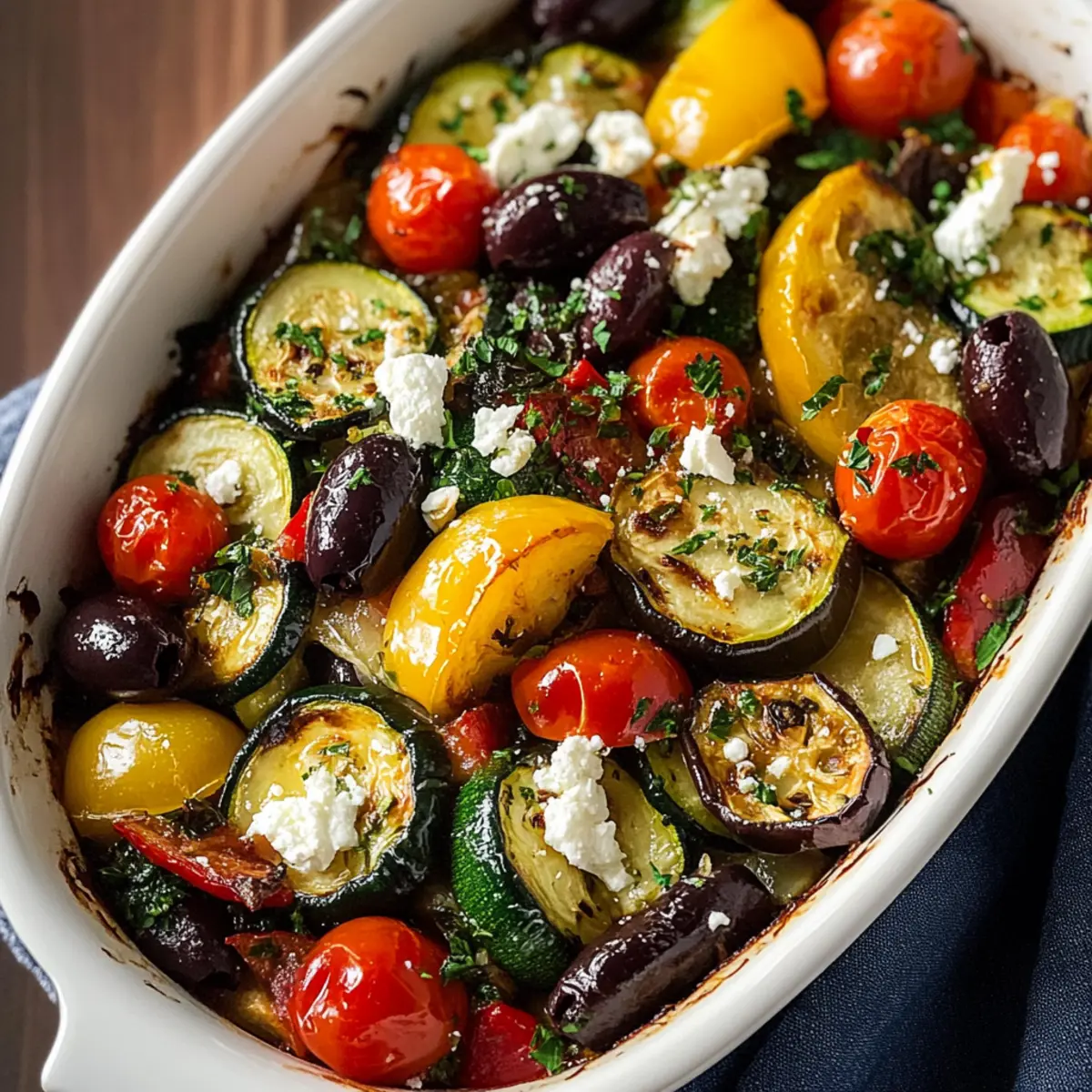
Why is this casserole a must-try?
Colorful and Inviting: You’ll love watching this dish come to life in your oven, turning into a golden, bubbling masterpiece!
Healthy Ingredients: Packed with nutrient-rich vegetables, it’s a guilt-free way to indulge in Mediterranean flavors.
Quick to Prepare: With just 20 minutes of prep time, it’s a lifesaver for those busy nights when you crave something wholesome yet delightful.
Versatile Options: Feel free to customize with seasonal veggies or your favorite cheese, making it unique every time you cook!
Family-Friendly Appeal: This casserole is sure to impress everyone at the table, from picky eaters to gourmet lovers. Enjoy it as a main course or a tasty side!
If you’re interested in more effortless, nutritious meals, check out our healthy weeknight recipes to keep your menu fresh!
Mediterranean Vegetable Casserole Ingredients
• For the Casserole
- Zucchini – Adds a mild, buttery flavor and tender texture when baked. Substitution: Yellow squash works well too.
- Eggplant – Absorbs flavors and becomes melt-in-your-mouth soft. Prep Note: Salt and let sit to remove bitterness.
- Red Bell Pepper – Provides color and fruity sweetness to balance savory flavors. Substitution: Any color pepper can be used.
- Yellow Bell Pepper – Enhances visual appeal with a tangy sweetness. Substitution: Can be replaced with more red bell pepper if desired.
- Red Onion – Adds natural sweetness and a hint of sharpness when roasted. Substitution: White onion can be used for a milder flavor.
- Garlic – Infuses an aromatic punch for added warmth. Preparation: Use fresh minced garlic for the best flavor.
- Cherry Tomatoes – Bursts of acidity that add brightness and juiciness. Substitution: Any small tomato variety can be used.
- Olive Oil – Coats vegetables for even cooking and promotes browning. Note: Use extra virgin for the best flavor.
- Dried Oregano – Ties flavors together with a woodsy note. Substitution: Dried thyme or Italian seasoning can be used.
- Dried Basil – Adds refreshing hints that cut through richness. Substitution: Can use fresh basil, but reduce quantity by half.
- Salt and Pepper – Basic seasonings to enhance natural flavors.
- Feta Cheese – Provides a creamy, tangy finish. Substitution: Goat cheese adds a similar flavor.
- Kalamata Olives – Adds a savory, briny depth, enhancing Mediterranean authenticity. Substitution: Any brined olives work well.
- Parsley – Offers freshness and herbaceous notes. Note: Both curly and flat-leaf parsley can be used.
- Grated Parmesan Cheese – Contributes a nutty crust and additional flavor depth. Substitution: Nutritional yeast for a vegan option.
- Balsamic Vinegar – Adds sweet-tart brightness, enhancing the dish just before serving.
Enjoy crafting this delightful Mediterranean Vegetable Casserole, and let the cooking adventure begin!
Step‑by‑Step Instructions for Mediterranean Vegetable Casserole
Step 1: Preheat the Oven
Begin by preheating your oven to 400°F (200°C). This temperature is crucial for achieving perfectly roasted vegetables in your Mediterranean Vegetable Casserole. While the oven heats up, gather your baking dish and prepare your fresh ingredients, setting the stage for a flavorful meal.
Step 2: Prepare the Vegetables
In a large mixing bowl, layer your sliced zucchini, eggplant, both red and yellow bell peppers, red onion, and halved cherry tomatoes. This vibrant mix will create a stunning visual appeal in your casserole. Ensure the vegetables are evenly distributed in the bowl for the best flavor infusion during cooking.
Step 3: Season and Oil the Mixture
Add freshly minced garlic to the bowl along with a generous drizzle of olive oil, and sprinkle with dried oregano, basil, salt, and pepper. Toss everything together until each vegetable is thoroughly coated. This step enhances the flavors of your Mediterranean Vegetable Casserole, ensuring a delectable bite every time.
Step 4: Spread in the Baking Dish
Transfer the seasoned vegetable mixture into a large baking dish, spreading it out evenly to ensure even cooking. Take care to create a single layer, which will allow the vegetables to roast beautifully, caramelizing their natural sugars and enhancing their flavors as they bake.
Step 5: Bake the Casserole
Place the baking dish in your preheated oven and bake for 35–40 minutes. You’ll know it’s ready when the vegetables are tender and lightly browned at the edges. The medley will emit a delightful aroma, signaling that a delicious Mediterranean Vegetable Casserole is on its way.
Step 6: Add Cheese and Olives
Once baked, remove the casserole from the oven and sprinkle crumbled feta cheese and sliced kalamata olives on top. These ingredients add creaminess and a savory touch, elevating the overall taste. Carefully return the dish to the oven for an additional 5–7 minutes until the cheese starts to soften.
Step 7: Finish with Garnishes
After the cheese is warmed, take the casserole out once again and drizzle with balsamic vinegar. This brightens the dish beautifully. Finally, sprinkle fresh parsley and grated Parmesan cheese on top for extra flavor and a lovely finishing touch, making your Mediterranean Vegetable Casserole visually appealing and appetizing.

What to Serve With Savory Baked Mediterranean Vegetable Casserole
Transform your Mediterranean experience into a delightful feast that tantalizes your taste buds and warms your heart.
- Crusty Bread: Perfect for soaking up the aromatic juices, a thick slice of crusty bread takes every bite to the next level.
- Simple Green Salad: A refreshing salad with crisp lettuce, cucumbers, and a light vinaigrette brightens your meal and adds a crunch.
- Grilled Lemon Chicken: Juicy, lemony grilled chicken adds a protein-packed element, perfectly complementing the casserole’s rich flavors.
- Quinoa Pilaf: Fluffy quinoa flavored with herbs offers a nutty contrast that pairs beautifully with the savory vegetables.
- Roasted Garlic Mashed Potatoes: Creamy mashed potatoes infused with roasted garlic provide a luscious texture that harmonizes with the vegetable medley.
- Tzatziki Sauce: This cool, yogurt-based dip is a delightful contrast to the warm casserole, refreshing every bite.
- Herbed Couscous: Light and fluffy, couscous seasoned with fresh herbs enhances the Mediterranean theme and adds another layer of flavor.
- Glass of Red Wine: A smooth red wine like a Chianti enriches your dining experience, rounding out the bold flavors of the casserole.
- Baklava for Dessert: End the meal on a sweet note with flaky baklava drizzled in honey, introducing a delightful Mediterranean twist.
Expert Tips for Mediterranean Vegetable Casserole
-
Even Sizing: Ensure all vegetables are cut to similar sizes for even cooking, avoiding some being undercooked while others may be mushy.
-
Coat Well: Toss the vegetables with your hands to ensure a thorough coating of olive oil and spices. This enhances flavors and prevents sticking.
-
Watch the Salt: Adjust the amount of salt according to the saltiness of the feta and olives to avoid over-seasoning your Mediterranean Vegetable Casserole.
-
Layering Technique: For optimal flavor infusion, layer ingredients rather than piling them up in a mound; this helps with even roasting too.
-
Fresh Ingredients: Whenever possible, use fresh herbs and vegetables for the best flavor and nutrition in your casserole.
-
Storage Reminder: Let leftover Mediterranean Vegetable Casserole cool before transferring it to an airtight container; it stays fresh for up to 3 days in the fridge!
Make Ahead Options
This Mediterranean Vegetable Casserole is a fantastic option for meal prep enthusiasts! You can chop and prepare all your vegetables (zucchini, eggplant, bell peppers, red onion, and cherry tomatoes) up to 24 hours in advance. Just store them in an airtight container in the refrigerator to maintain their freshness. To further save time, you can mix the seasoned vegetables with olive oil, garlic, and herbs, refrigerating them until you’re ready to bake. When you’re prepared to serve, simply spread the mixture in a baking dish and bake as directed. This way, you’ll have a delicious, hassle-free meal ready to impress your family with minimal effort!
How to Store and Freeze Mediterranean Vegetable Casserole
Fridge: Store leftover Mediterranean Vegetable Casserole in an airtight container for up to 3 days. This keeps the flavors intact and the vegetables fresh.
Freezer: To freeze, portion the casserole into smaller containers or wrap tightly in plastic wrap for a maximum storage time of 2–3 months. Thaw overnight in the fridge before reheating.
Reheating: For the best texture, reheat the casserole in the oven at 350°F (175°C) for about 15–20 minutes, or until heated through. Avoid the microwave to maintain the dish’s yummy qualities.
Airtight Packaging: Always ensure that your container is sealed well to prevent freezer burn or stale flavors. This will allow you to enjoy your Mediterranean Vegetable Casserole to the fullest!
Mediterranean Vegetable Casserole Variations
Let your culinary creativity shine and make this dish your own with some delightful twists and tweaks!
-
Dairy-Free: Substitute feta and Parmesan with vegan cheese or nutritional yeast for a satisfying yet dairy-free option. It still brings that savory depth while keeping it plant-based.
-
Spicy Kick: Add red pepper flakes or diced jalapeños for a fiery twist that complements the fresh flavors beautifully. Just a sprinkle can transform the dish into a spicy sensation!
-
Added Protein: Incorporate drained canned chickpeas or cooked lentils to enhance the protein content and make this casserole even heartier. This twist pairs perfectly with the veggies for a filling meal.
-
Seasonal Veggies: Toss in seasonal delights like asparagus, spinach, or butternut squash for a fresh seasonal flair that changes with the harvest. Embrace the flavors of the season!
-
Whole Grain Boost: Mix in cooked quinoa or farro for added texture and a nutty flavor that complements the vegetables superbly. This addition makes your casserole even more filling and nutritious!
-
Herb Medley: Experiment with fresh herbs such as thyme, rosemary, or even dill to elevate the flavors. Each herb brings a unique character that can redefine your casserole experience.
-
Nutty Crunch: Top with toasted pine nuts or sliced almonds before serving for an unexpected and delicious crunch. This adds a lovely textural contrast to the creamy feta and tender vegetables.
-
Citrus Zest: Brighten your casserole with a splash of fresh lemon juice or a sprinkle of lemon zest just before serving. This small addition can uplift the dish’s overall flavor and freshness!
Don’t forget to serve this Mediterranean Vegetable Casserole with a refreshing simple green salad for a balanced meal that’s both satisfying and nutritious. Enjoy the journey of flavors!
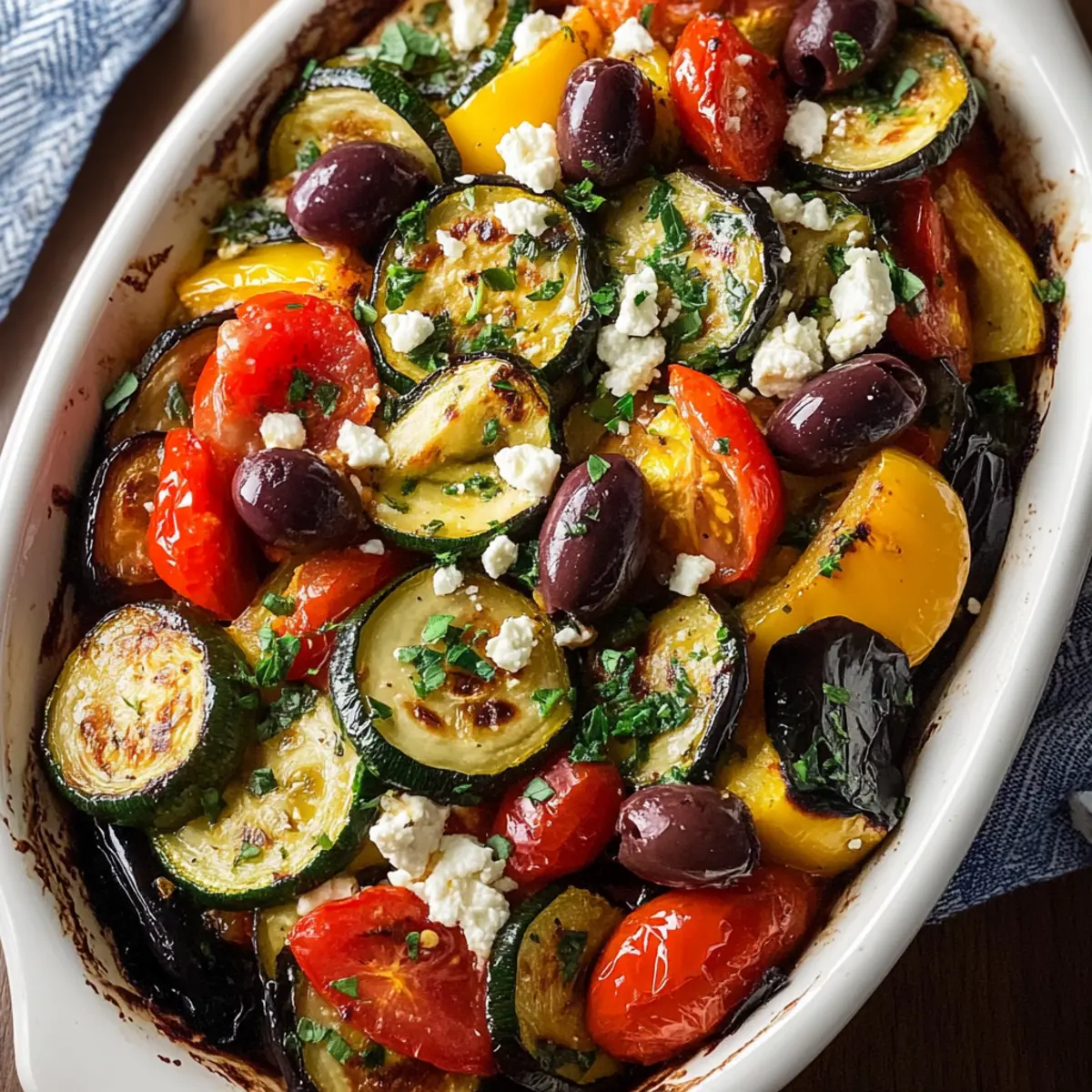
Mediterranean Vegetable Casserole Recipe FAQs
What vegetables should be ripe for the best flavor?
Absolutely! For the best flavor in your Mediterranean Vegetable Casserole, choose ripe, colorful vegetables. Look for zucchinis that are firm and glossy, eggplants with shiny skin free of dark spots, and bell peppers that are vibrant in color. Ripe tomatoes will have a slight give when gently squeezed and should be fragrant.
How do I store leftover Mediterranean Vegetable Casserole?
Store any leftover Mediterranean Vegetable Casserole in an airtight container in the refrigerator for up to 3 days. Make sure to let it cool to room temperature before sealing it up, as this helps retain its flavors and texture.
Can I freeze Mediterranean Vegetable Casserole, and if so, how?
Absolutely! To freeze your casserole, wait until it’s completely cool, then portion it into smaller containers or wrap tightly in plastic wrap. It can be stored in the freezer for up to 2–3 months. When you’re ready to enjoy it again, simply thaw overnight in the refrigerator and reheat in the oven for the best results.
What should I do if my casserole gets watery?
If you find your Mediterranean Vegetable Casserole is watery, it may be due to excess moisture from the vegetables. You can remedy this by slicing your eggplant and salting it beforehand to draw out moisture. Additionally, try baking it a bit longer to allow some of the liquid to evaporate, making for a thicker, more flavorful dish.
Are there any dietary considerations for this dish?
Yes! The Mediterranean Vegetable Casserole is gluten-free and vegetarian, making it suitable for many dietary needs. However, if you’re serving pets, be cautious with ingredients like garlic and onions, which can be harmful to dogs and cats. If you have guests with specific allergies (like dairy or nuts), consider omitting feta cheese or using a dairy-free alternative to keep everyone in mind.
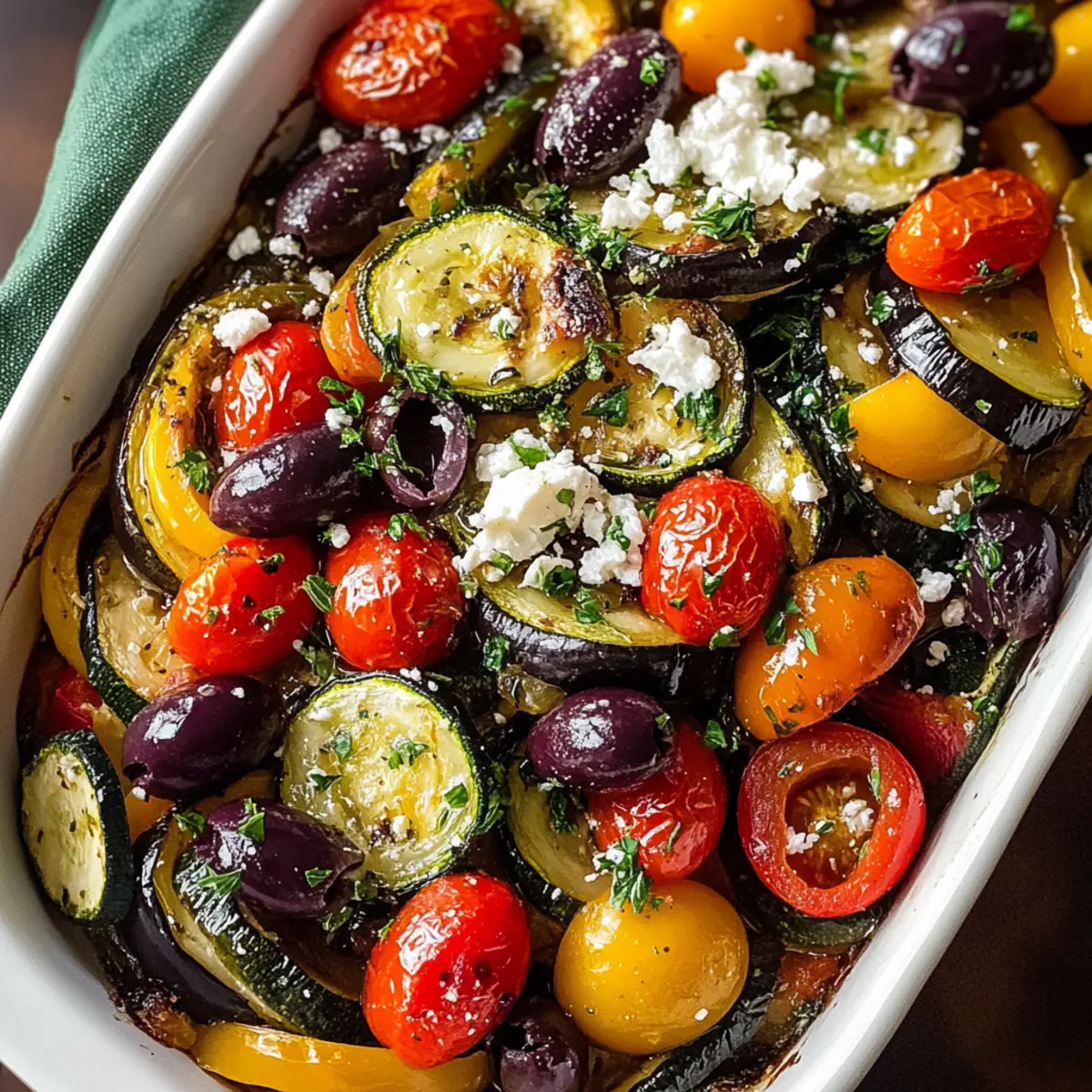
Mediterranean Vegetable Casserole: A Healthy Flavor Boost
Ingredients
Equipment
Method
- Preheat your oven to 400°F (200°C).
- In a large mixing bowl, layer sliced zucchini, eggplant, both red and yellow bell peppers, red onion, and halved cherry tomatoes.
- Add freshly minced garlic, olive oil, dried oregano, basil, salt, and pepper. Toss until vegetables are coated.
- Transfer the mixture into a large baking dish and spread out evenly.
- Bake for 35–40 minutes until vegetables are tender and lightly browned.
- Remove from oven and sprinkle feta cheese and kalamata olives on top. Return to oven for another 5-7 minutes until cheese softens.
- Drizzle with balsamic vinegar, and sprinkle with parsley and parmesan cheese before serving.



